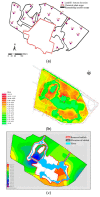Research on Water Environment Regulation of Artificial Playground Lake Interconnected Yangtze River
- PMID: 30257493
- PMCID: PMC6211040
- DOI: 10.3390/ijerph15102110
Research on Water Environment Regulation of Artificial Playground Lake Interconnected Yangtze River
Abstract
With the rapid development of China, water pollution is still a serious problem despite implementation of control measures. Reasonable water environment management measures are very important for improving water quality and controlling eutrophication. In this study, the coupled models of hydrodynamics, water quality, and eutrophication were used to predict artificial Playground Lake water quality in the Zhenjiang, China. Recommended "unilateral" and "bilateral" river numerical models were constructed to simulate the water quality in the Playground Lake without or with water diversion by pump, sluice and push pump. Under "unilateral" and "bilateral" river layouts, total nitrogen and total phosphorus meet the landscape water requirement through water diversion. Tourist season in spring and summer and its suitable temperature result in heavier eutrophication, while winter is lighter. Under pumping condition, water quality and eutrophication of "unilateral" river is better than "bilateral" rivers. Under sluice diversion, the central landscape lake of "unilateral river" is not smooth, and water quality and eutrophication is inferior to the "bilateral". When the water level exceeds the flood control level (4.1 m), priority 1 is launched to discharge water from the Playground Lake. During operation of playground, when water level is less than the minimum level (3.3 m), priority 2 is turned on for pumping diversion or sluice diversion to Playground Lake. After opening the Yangtze river diversion channel sluice, priority 3 is launched for sluice diversion to the Playground Lake. When the temperature is less than 15 °C, from 15 °C to 25 °C and higher than 25 °C, the water quality can be maintained for 15 days, 10 days and 7 days, respectively. Corresponding to the conditions of different priority levels, reasonable choices of scheduling measures under different conditions to improve the water quality and control eutrophication of the Playground Lake. This article is relevant for the environmental management of the artificial Playground Lake, and similar lakes elsewhere.
Keywords: Playground Lake; bilateral rivers; eutrophication remediation; numerical simulation; unilateral river.
Conflict of interest statement
The authors declare no conflict of interest.
Figures























References
-
- Zhao X., Shen Z.Y., Xiong M., Qi J. Key uncertainty sources analysis of water quality model using the first order error method. Int. J. Environ. Sci. Technol. 2011;8:137–148. doi: 10.1007/BF03326203. - DOI
-
- Piermay J.L. Long-term simulation of the eutrophication of the North Sea: Temporal development of nutrients, chlorophyll and primary production in comparison to observations. J. Sea Res. 1997;38:275–310. doi: 10.1016/S1385-1101(97)00051-8. - DOI
-
- Nobre A.M., Ferreira J.G., Newton A., Simas T., Icely J.D., Neves R. Management of coastal eutrophication: Integration of field data, ecosystem-scale simulations and screening models. J. Mar. Syst. 2005;56:375–390. doi: 10.1016/j.jmarsys.2005.03.003. - DOI
-
- Madden C.J., Kemp W.M. Ecosystem model of an estuarine submersed plant community: Calibration and simulation of eutrophication responses. Estuaries. 1996;19:457–474. doi: 10.2307/1352463. - DOI
Publication types
MeSH terms
Substances
LinkOut - more resources
Full Text Sources
Other Literature Sources

